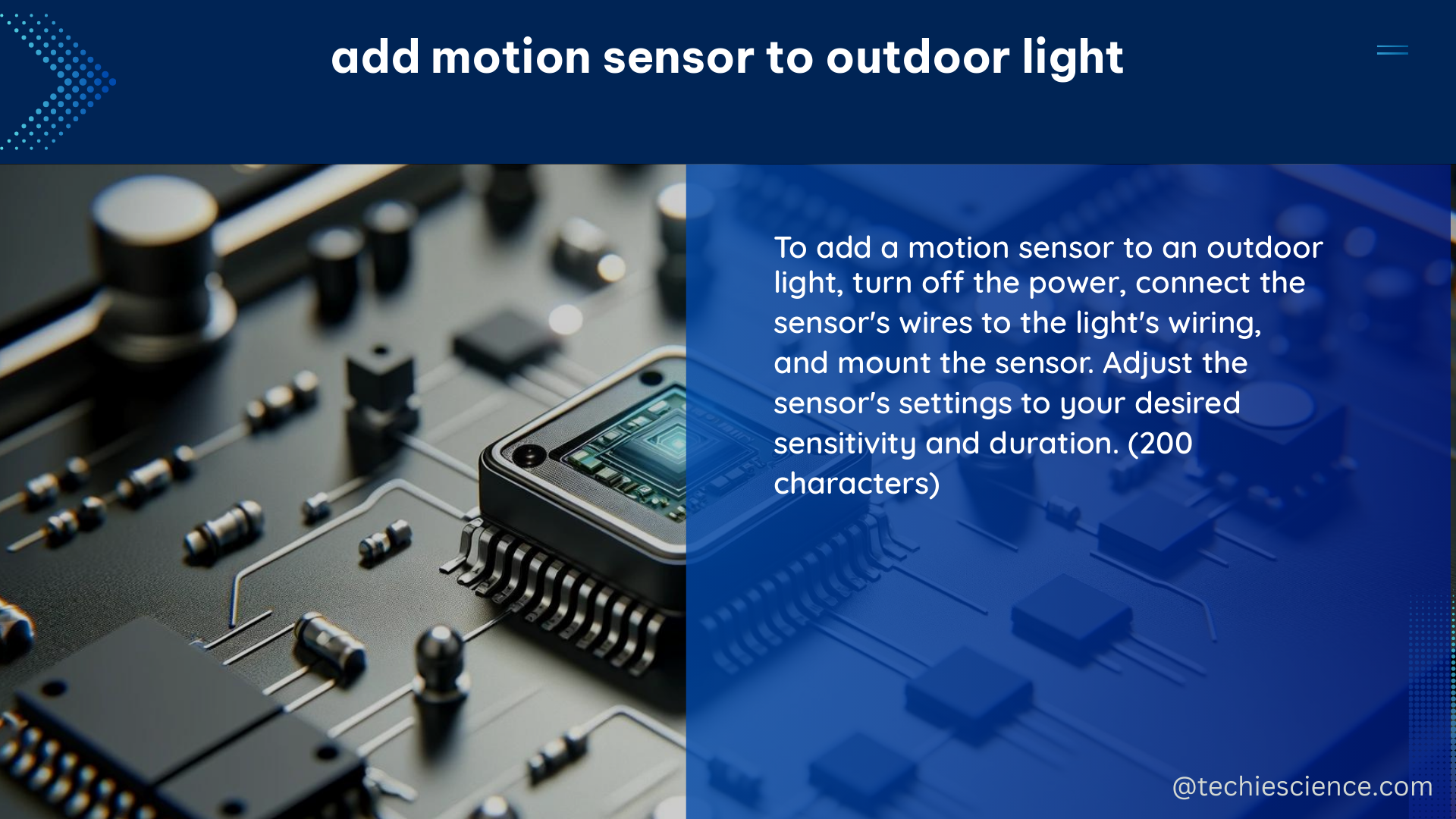Adding a motion sensor to an outdoor light can enhance the security and energy efficiency of your home. By choosing the right motion sensor and following the proper wiring instructions, you can easily convert your existing outdoor light into a motion-sensing one. This comprehensive guide will walk you through the process step-by-step, providing you with the technical details and expert insights to ensure a successful installation.
Understanding Motion Sensor Specifications
When selecting a motion sensor for your outdoor light, it’s crucial to consider the following key specifications:
Detection Range
The detection range of a motion sensor determines the maximum distance at which it can detect movement. For outdoor use, you’ll want a sensor with a longer range, typically up to 70 feet, to cover a larger area.
Field of View
The field of view (FOV) of a motion sensor refers to the angle at which it can detect movement. For outdoor applications, a wider FOV, up to 240 degrees, is preferred to provide comprehensive coverage.
Sensitivity
Motion sensor sensitivity can be adjusted to control the level of movement required to trigger the light. For outdoor use, you may want a sensor with adjustable sensitivity to account for factors like wind, small animals, or passing vehicles.
Power Supply
Outdoor motion sensors are typically designed to operate on 120V AC power, which matches the standard voltage for most residential electrical systems.
Wiring Connections
Motion sensors for outdoor lights will have three main wire connections: line (power input), load (light output), and neutral. Ensure that the sensor you choose is compatible with your existing wiring setup.
Enclosure Rating
To withstand the elements, an outdoor motion sensor should have a waterproof and dustproof enclosure, typically rated at least IP65 or higher.
Replacing the Light Bulb with a Motion-Sensing One

One of the easiest ways to add a motion sensor to an outdoor light is to replace the existing light bulb with a motion-sensing one. These specialized bulbs come with a built-in motion sensor and can be easily screwed into the existing light fixture.
When choosing a motion-sensing light bulb, consider the following:
- Bulb type (e.g., LED, CFL, incandescent)
- Wattage and lumen output
- Sensor range and field of view
- Adjustable sensitivity settings
- Weatherproof rating (e.g., IP65 or higher)
To install a motion-sensing light bulb, simply remove the old bulb and screw in the new one. Ensure that the power to the light fixture is turned off before making the replacement.
Installing a Separate Motion Sensor
If you prefer to keep your existing outdoor light fixture, you can install a separate motion sensor that can be connected to the light. This approach allows you to control multiple lights with a single sensor.
Step 1: Locate the Wiring
Identify the switch box or junction box that controls the outdoor light you want to connect the motion sensor to. You’ll need access to the wiring from this box to the light fixture.
Step 2: Mount the Motion Sensor
Choose a suitable location to mount the motion sensor, typically on the wall plate or near the light fixture. Ensure that the sensor has a clear line of sight to the area you want to monitor.
Step 3: Wire the Motion Sensor
Disconnect the power to the light circuit at the circuit breaker. Then, follow these steps to wire the motion sensor:
- Connect the line (hot) wire from the switch box to the line terminal on the motion sensor.
- Connect the load (switched) wire from the light fixture to the load terminal on the motion sensor.
- Connect the neutral wire from the switch box to the neutral terminal on the motion sensor.
- If your motion sensor has a ground wire, connect it to the ground terminal in the switch box or light fixture.
Step 4: Secure the Wiring
Carefully tuck the wired connections into the switch box or a separate enclosure, ensuring that they are properly insulated and secured.
Step 5: Test and Adjust the Motion Sensor
Restore power to the circuit and test the motion sensor by walking within its detection range. Adjust the sensitivity and other settings as needed to achieve the desired performance.
Troubleshooting and Maintenance
If you encounter any issues with your motion-sensing outdoor light, consider the following troubleshooting steps:
- Check the power supply and wiring connections to ensure they are secure and undamaged.
- Verify that the motion sensor is properly mounted and has a clear line of sight to the monitored area.
- Adjust the sensitivity and detection range settings to optimize the sensor’s performance.
- Clean the motion sensor’s lens and housing to remove any dirt or debris that may be interfering with its operation.
- Replace the motion sensor or light bulb if they are malfunctioning or have reached the end of their lifespan.
Regular maintenance, such as cleaning the sensor and checking for any loose connections, can help ensure the long-term reliability and performance of your motion-sensing outdoor light.
By following the guidelines and technical specifications outlined in this comprehensive guide, you can successfully add a motion sensor to your outdoor light, enhancing the security and energy efficiency of your home.
References:
- Converting Exterior Light to Motion Sensor Light
- Adding Motion Sensor to Existing Flood Light Circuit
- How to Add Motion Sensor to Outdoor Lights Function
- Outdoor Lighting Control Systems with Motion Sensors
- Add Motion Sensor Driven Floodlights to Existing Regular Outdoor Lamp

The lambdageeks.com Core SME Team is a group of experienced subject matter experts from diverse scientific and technical fields including Physics, Chemistry, Technology,Electronics & Electrical Engineering, Automotive, Mechanical Engineering. Our team collaborates to create high-quality, well-researched articles on a wide range of science and technology topics for the lambdageeks.com website.
All Our Senior SME are having more than 7 Years of experience in the respective fields . They are either Working Industry Professionals or assocaited With different Universities. Refer Our Authors Page to get to know About our Core SMEs.